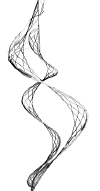Ojibwe Art
When most people think of art, the first things that come to
mind are objects in a museum. They think of paintings or sculptures that
they can admire ó but only from afar. Rarely do people think of art as
something that is a part of what they use everyday. But thatís how Ojibwe
People have traditionally viewed their art.
In the Ojibwe culture, it has always been important to make objects that are
used everyday as beautiful as possible. Thatís because everything people
make is out of respect for the Great Spirit. Long before the Europeans came
to North American, Indian people would use objects from their natural
surroundings to make things they needed. They would then incorporate the
areaís landscape in the designs that they put on them. For example, a
container might be made of birchbark and then decorated with flowers special
to the area. That way, the container was both useful and beautiful.
An important aspect of these designs was the individuality behind each one.
Every design was an expression of someoneís creativity, and people did not
have to be artists to express themselves.
Indian tribes across North America traded ideas and materials with one
another. The Ojibwe, who eventually settled in the wooded areas of the upper
midwest, were known nationwide for their floral designs. Tribes who settled
in the southwest and other regions had their own designs. The tribes learned
from one another and often experimented with one anotherís art forms.
Today, Ojibwe art continues to flourish thanks to Elders, such as Mille Lacs
Band member Batiste Sam, and a new generation of artists, such as Band
member and Grand Casino Hinckley Associate Steve Premo. Batiste Sam is
famous worldwide for her beading designs, and Steve Premo is renowned
locally for his wildlife and American Indian themes.
Indian Art: Authenticity
In recent years, Indian art has dramatically increased in
popularity. Dream catchers are seen everywhere, as are birchbark baskets,
beaded jewelry, and medallions. As demand has increased, countries like
China and Indonesia have started producing replicas of popular Indian art
items. But, the replicas are not made with the same care, nor are they the
result of a unique Indian culture that has been producing art throughout
history.
The Indian culture believes that everything is a gift from
the Great Creator and that they should make the most out of everything they
have. Crafting beautiful pieces of art, using supplies that nature has
provided, has always been an important part of Indian tradition.
Southwestern Indians use turquoise and silver to craft
beautiful and intricate jewelry. Indians who live near the North Coast carve
wood and design pieces of art using shells from the ocean. And Northwood
Indians make baskets and other items out of the abundant bark of birch
trees.
Making the most out of what you have also involves taking
great care to turn common objects into art that is pleasing to the eyes.
Pipestone peace pipes are carved and then lined with eagle feathers, quills,
and beadwork, and moccasins and ceremonial dresses are adorned with colorful
beads.
Since the arrival of Europeans, Indians have crafted their
now famous star quilts. Before that time, garments were fashioned out of
buckskin and soft hides, because cotton and silk materials were not
available. However, after the Indians were introduced to these fabrics, it
seemed natural to craft beautiful blankets out of the material that was
available.
Today, as Indian art penetrates popular culture, the
billion dollar American Indian arts and crafts market is experiencing
growing sales of replica products being represented as produced by American
Indians. In response to this, Congress passed the Indian Arts and Crafts Act
of 1990. This is essentially a truth-in-advertising law designed to prevent
marketing products as "Indian made" when the products are not, in fact, made
by a federally recognized or state-recognized tribe. This unfortunately
establishes the whiteman's government as the arbiter of who is "Indian".
Little Shell had refused to accept the pittance offered for his band's huge
lands and even though the Band won in the Indian Claims Court, the money was
never paid and they were never recognized.
It is often difficult to determine if Indian art is
authentic or whether it is a replica. Precautions can be taken to ensure
that you are getting the real thing. Be cautious of who you are buying it
from and make sure to check the item for the word "authentic." This word
signals that you are receiving a true piece of American Indian culture.
Powwows
A powwow is a celebration of Indian heritage and tradition
which originated thousands of years ago. Indian People gather with family
and friends to celebrate life, to give thanks to all the Creator has given,
to enjoy traditional food and activities, to hear the words of Elders, and
to sing and dance.
Two exciting powwows take place on the Mille Lacs
Reservation each summer. At the annual competition powwow in Hinckley,
Indians from all over the Midwest enter singing and dancing contests. Some
of the dances performed include traditional, fancy, jingle and grass dances.
In addition, participants sing traditional songs and introduce new songs
accompanied by drums.
Attendees also enjoy a top-notch rodeo starring the best
Indian riders in the country. Because so many people in the region love
horsemanship, Hinckley is an ideal location for the event. American Indian
cowboys come from all over the United States come to participate in the
rodeo and to meet other participants.
The power and beauty of Indian culture also is celebrated
at the Mille Lacs Iskigamizigan (Maple Sugar Bush) powwow grounds on the
shores of Mille Lacs Lake in August. Participants tell stories through
intricate dances, dazzling outfits, and stirring songs. To serve visitors
who come from all over the United States and Canada, the Band has created a
camping ground and picnic tables as part of the powwow grounds.
Although powwows are American Indian celebrations, the
Mille Lacs Band invites people of all backgrounds to come share in these
unique cultural events. Admission is free to both events.
White Eagle Soaring: Dream Dancer of the 7th Fire








 Get
a course to promote your business online, explode your sales
Get
a course to promote your business online, explode your sales Get
software to promote your business online in less time
Get
software to promote your business online in less time Get
software to streamline your business and run it hands free.
Get
software to streamline your business and run it hands free.